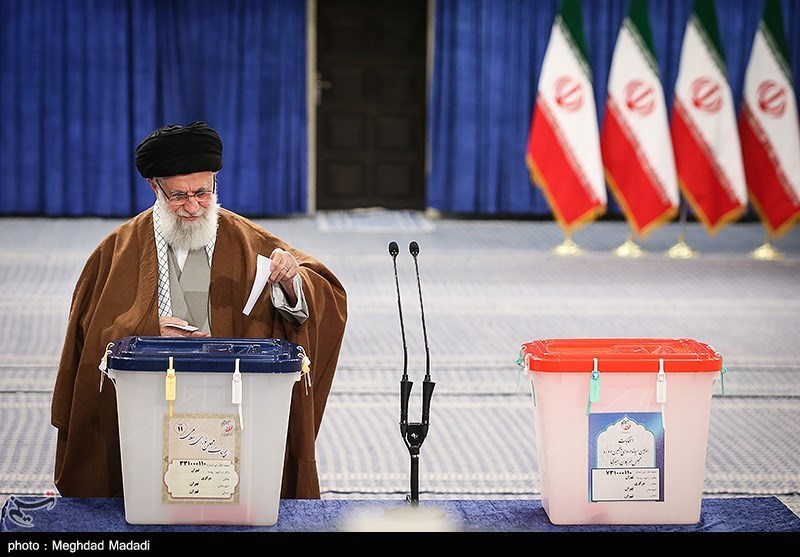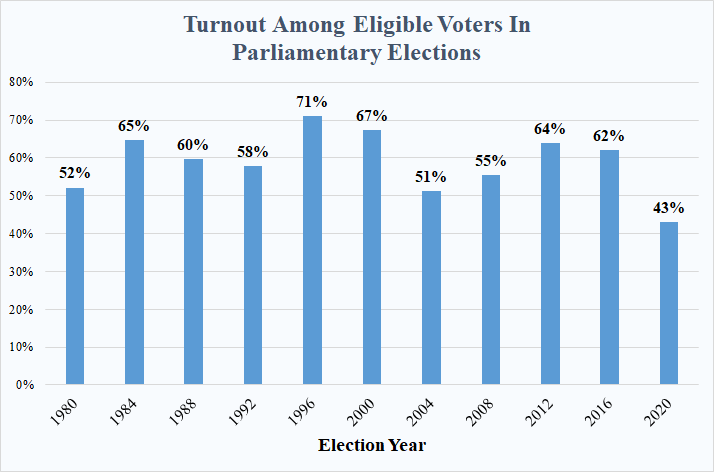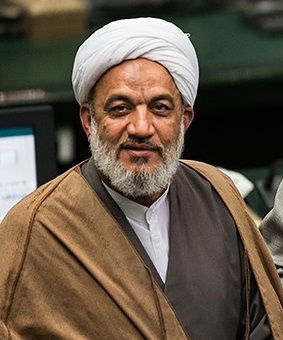Conservative and hardline factions, including candidates closely aligned with the Revolutionary Guards, won a sweeping victory in parliamentary elections held on February 21. They won 221 of the 290 seats, more than doubling their presence in parliament; 83 were elected in the 2016 poll, according to Icana, the parliamentary news agency. Also known as “principlists,” they are committed to rigid interpretations of revolutionary principles.
In a major setback for allies of President Hassan Rouhani, only 19 reformists or centrists won seats. In the 2016 election, reformists and centrists won 121 seats, six times more than in 2020. Independents won 38 seats, twice as many as reformists. Iran has 82 national political parties and 34 provincial parties.
The turnout was only 42.6 percent, the lowest since the 1979 revolution. The regime, which cites turnout as a reflection of public support, downplayed the low turnout. The election came just days after the outbreak of the first cases of the new coronavirus in Iran. Supreme Leader Ayatollah Ali Khamenei blamed Iran’s “enemies” for exaggerating the threat. “This negative propaganda about the virus began a couple of months ago and grew larger ahead of the election,” he said during a lecture on February 23. “Their media did not miss the tiniest opportunity for dissuading Iranian voters and resorting to the excuse of disease and the virus.”

Interior Minister Abdolreza Rahmani Fazli said the turnout was “quite acceptable” given concerns about the virus and the political atmosphere. The election also took place after months of internal protests and showdowns with the outside world. Many Iranians were also reportedly apathetic after the disqualification of thousands of candidates, mostly reformists. Some reformist politicians in Iran called for a boycott of the election.

Conservatives had a major advantage because they had little to no competition in most races. The powerful Guardian Council – an unelected panel of 12 Islamic jurists and scholars – disqualified 7,296 candidates out of the more than 14,500 who registered to run. Some 75 incumbents, mostly moderates and reformists were barred. The vetting prevented reformists from fielding candidates for 230 out of parliament’s 290 seats.
Winners
- 221 conservatives/principlists
- 20 reformists and centrists
- 38 independents
On April 17, a second round will be held to decide the remaining 11 seats. The new session of parliament will begin in May.
In Tehran, conservatives won all 30 seats. The outcome in the capital has long been viewed a bellwether for elite sentiment in Iran, according to a report by Harvard’s Belfer Center. Tehran has the largest share of parliamentary seats of any of the 31 provincial blocs. In the previous election, reformists and centrists had taken all of Tehran’s 30 seats. Conservatives also made gains in Yazd and Tabriz, which had been reformist strongholds.
Major Figures
Mohammad Baqer Qalibaf, the former mayor of Tehran and former commander of the Revolutionary Guards Aerospace Force, took first place in the race for Tehran. He won more than 1.2 million votes, more than any other candidate in the capital. Qalibaf headed the list of candidates from the Coalition Council of the Islamic Revolution Forces. Qalibaf became a strong contender for the speakership.
Ghalibaf who is seeking to be speaker of future parliament in #Iran has published a new video saying new parliament will work hard to rid people from US pressure. By highlighting “strong & popular economy”, he said his slogan for the fight against #US is “work, work & work”. pic.twitter.com/4oSc0vBvlF
— Abas Aslani (@AbasAslani) February 23, 2020
Mostafa Mir Salim, the head of the conservative Islamic Coalition Party, came in second from Tehran. He was culture minister from 1994 to 1997. Qalibaf and Mir Salim were rivals for leadership of the conservative movement. Both ran unsuccessful campaigns for the presidency in 2017.

Morteza Agha Tehrani took Tehran’s third spot. The influential cleric headed the ultraconservative Endurance Front of the Islamic Revolution’s list. The party is aligned with hardline cleric Ayatollah Mesbah Yazdi. Shortly before the 2020 election, Qalibaf’s bloc formed a joint list with Agha Tehrani’s list.

Iranian candidates often run in loose coalitions rather than formal parties, mainly because of the difficulty in building name recognition and momentum in a short time. The campaign lasted only for a week. But party members are not disciplined about following their leadership. Iranians tend to vote mainly along factional lines—reformist, centrist, conservative or hardline.
Although many candidates campaign as part of a party or coalition list, the ballots do not have lists. Voters have to write down the names of individual candidates. Individual candidates can also appear on multiple lists to appeal to a broader swath of voters.
Political Impact
The new parliament is likely to further weaken President Hassan Rouhani, who is already a lame duck. Iran is scheduled to hold presidential elections in May 2021. Rouhani’s allies – a loose group of reformists, centrists and moderate conservatives – formed the largest bloc in the outgoing parliament.
In Iran’s obtuse political system, it’s hard to precisely categorize any politician; some labels are disputed. But this is the rough breakdown of Iran’s 10th parliament, which was elected in 2016.
- 83 conservatives/principlists
- 121 reformists and centrists
- 86 independents
Many of the new lawmakers opposed the 2015 nuclear deal, one of Rouhani’s main initiatives. The new parliament may also strengthen the hand of the Revolutionary Guards, the most powerful branch of Iran’s military and important economic player. “Regardless of the result and political inclinations of those elected, we thank the people for the sake of their presence,” Rouhani said two days after the election, in a nod to the conservative victory.
Photo Credits: Mostafa Mir Salim via Wikimedia Commons (CC by 4.0); Morteza Agha Tehrani by Erfan Kouchari for Tasnim News Agency / CC BY (https://creativecommons.org/licenses/by/4.0); Mohammad Baqer Qalibaf via Tasnim News Agency / CC BY (https://creativecommons.org/licenses/by/4.0)
